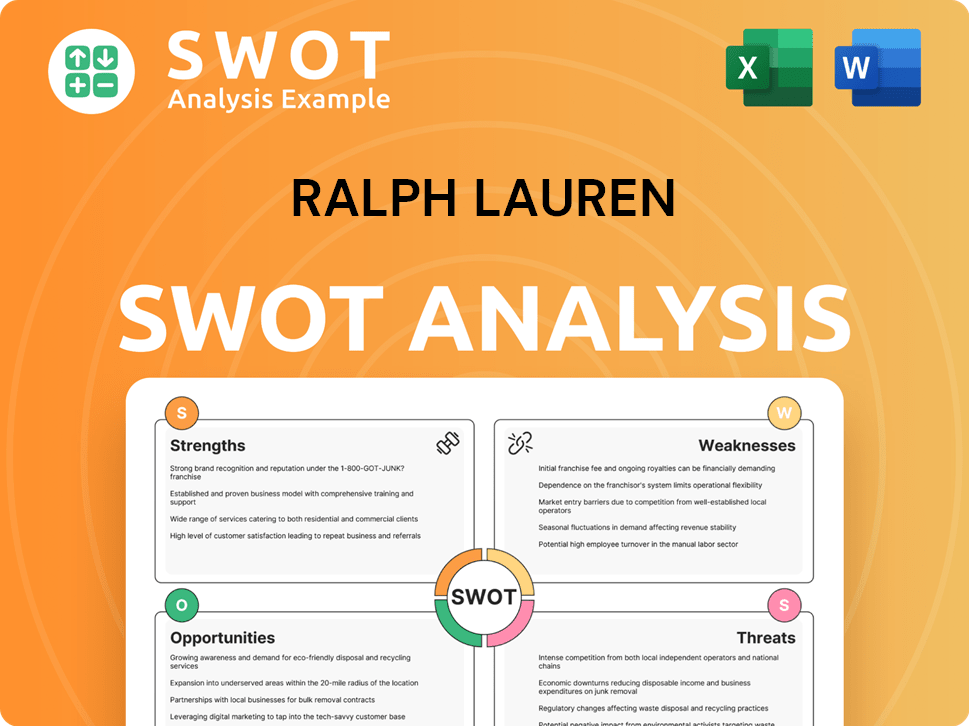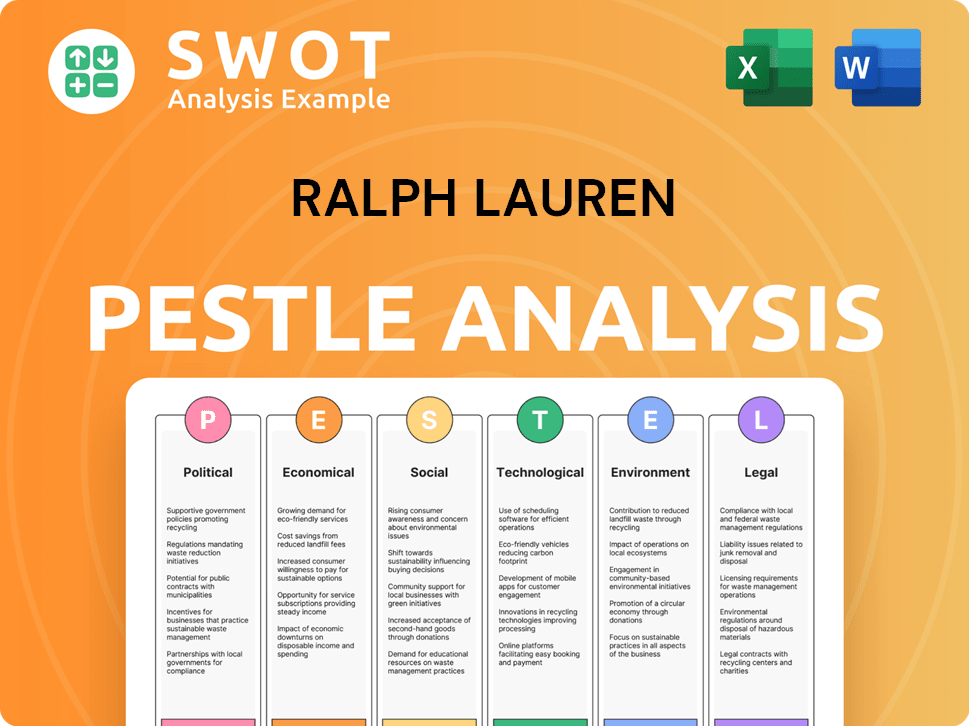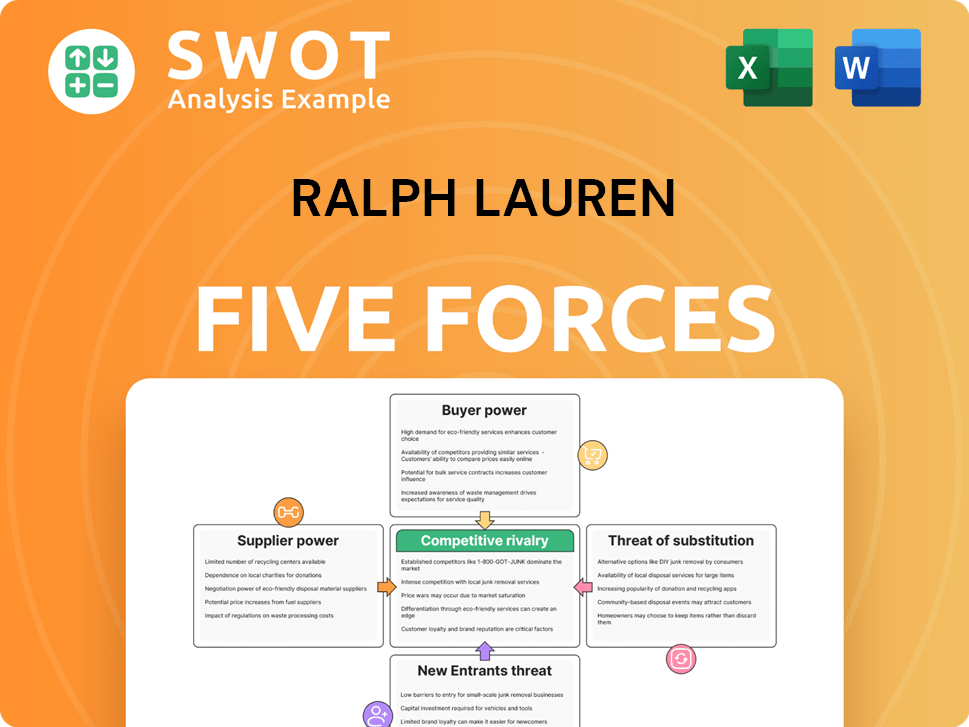Ralph Lauren Bundle
How Does Ralph Lauren Maintain Its Luxury Brand Status?
Discover the secrets behind Ralph Lauren's enduring success in the competitive fashion industry. From its inception, the company has masterfully cultivated a lifestyle brand, captivating consumers with its aspirational vision of American elegance. This analysis explores the Ralph Lauren SWOT Analysis, and how it has become a global leader in premium lifestyle products.

This exploration of Ralph Lauren's sales strategy and marketing strategy reveals how the company has consistently adapted to the changing landscape of the fashion industry. Understanding Ralph Lauren's business model offers valuable insights into its brand positioning, digital marketing initiatives, and retail sales performance. We will examine the key elements of its brand awareness campaigns and how it leverages its customer relationship management to drive sales growth strategies, including international marketing strategies and brand partnerships.
How Does Ralph Lauren Reach Its Customers?
The sales channels of the company are a crucial component of its overall Growth Strategy of Ralph Lauren, employing a multifaceted approach to reach a global customer base. This strategy effectively blends online and offline retail experiences, ensuring a broad market presence. The company's approach is designed to provide customers with a consistent brand journey across all touchpoints, reflecting its luxury positioning and commitment to customer engagement.
E-commerce platforms, especially RalphLauren.com, serve as primary direct-to-consumer (DTC) touchpoints, offering a comprehensive product range and a seamless shopping experience. Physical retail locations, including flagship stores, Polo stores, and factory stores, remain crucial for brand immersion and customer interaction. These stores are strategically located in key global fashion capitals and high-traffic retail destinations, providing a tangible representation of the brand's luxury image.
The evolution of these channels has been marked by a strategic shift towards a more integrated omnichannel experience. While initially relying heavily on wholesale distribution, the company has steadily increased its DTC focus, which offers greater control over brand presentation, pricing, and customer data. This shift has been instrumental in driving higher margins and fostering stronger customer relationships.
The company's e-commerce platforms, particularly RalphLauren.com, are primary direct-to-consumer (DTC) touchpoints. These platforms offer a comprehensive product range and a seamless shopping experience, crucial for the company's Ralph Lauren sales strategy. Digital channels have seen significant investment, aligning with the broader industry trend of increasing online penetration.
Physical retail locations, including flagship stores and factory stores, are crucial for brand immersion and customer interaction. These stores are strategically located in key global fashion capitals and high-traffic retail destinations. They provide a tangible representation of the brand's luxury image, supporting the company's Ralph Lauren marketing strategy.
Key partnerships with select luxury retailers and e-commerce platforms continue to play a role in expanding market reach. Wholesale distribution remains a part of the company's strategy, especially in international markets. The emphasis is on a balanced portfolio that prioritizes profitable growth and brand integrity, which is a key aspect of the Ralph Lauren business model.
The company is focused on providing customers with a consistent brand journey across all touchpoints, creating an integrated omnichannel experience. This approach includes seamless integration between online and offline channels. This strategy is designed to enhance customer engagement and brand loyalty, which is essential for luxury brand marketing.
The company's sales strategy emphasizes a balanced approach, blending DTC channels with strategic wholesale partnerships. This balance supports the company's brand positioning Ralph Lauren and ensures a broad market presence. The focus is on profitable growth and maintaining brand integrity.
- Direct-to-Consumer (DTC) Focus: Increasing the emphasis on DTC channels to enhance customer relationships and control brand presentation.
- Strategic Partnerships: Collaborations with luxury retailers and e-commerce platforms to expand market reach.
- Omnichannel Integration: Providing a consistent brand experience across all sales channels, both online and offline.
- Global Market Presence: Strategic locations in key fashion capitals and high-traffic retail destinations to enhance brand visibility.
Ralph Lauren SWOT Analysis
- Complete SWOT Breakdown
- Fully Customizable
- Editable in Excel & Word
- Professional Formatting
- Investor-Ready Format

What Marketing Tactics Does Ralph Lauren Use?
The marketing tactics employed by the [Company Name] are multifaceted, encompassing both digital and traditional strategies to enhance brand awareness and drive sales. These tactics are crucial components of the overall Ralph Lauren marketing strategy, designed to resonate with a diverse, global audience. The company's approach is consistently evolving, adapting to changing consumer behaviors and technological advancements.
Digital marketing plays a pivotal role, with content marketing, SEO, paid advertising, and influencer collaborations forming the core of its online presence. Traditional media, including print advertisements and event sponsorships, remain integral to reinforcing the brand's luxury positioning. Data-driven marketing and customer segmentation allow for personalized communications and product recommendations.
The company has been exploring immersive digital experiences and virtual activations to engage a younger, digitally-native demographic, including integrating Web3 technologies. This comprehensive approach is essential for maintaining its competitive edge in the fashion industry and ensuring continued sales growth.
Content marketing is a key strategy, with compelling narratives and visual content reinforcing the brand's image. SEO and paid advertising ensure high visibility in online searches and targeted outreach. Influencer partnerships amplify brand messages and connect with diverse audiences.
Social media platforms like Instagram, Facebook, and TikTok are actively used for brand storytelling and product launches. Direct engagement with consumers is a priority, fostering a strong brand community. These platforms are crucial for driving brand awareness campaigns.
High-end print advertisements in fashion magazines and strategic out-of-home placements remain part of the marketing mix. Select event sponsorships are used to reinforce the brand's luxury positioning. These traditional methods complement the digital efforts.
Customer segmentation strategies allow for highly personalized marketing communications. Product recommendations are based on individual preferences and purchase history. Analytics tools track campaign performance and optimize marketing spend.
The company explores immersive digital experiences and virtual activations to engage a younger demographic. Efforts to integrate Web3 technologies are part of this innovation. This approach ensures the brand remains relevant.
Collaborations with celebrities and other brands are a key component of the marketing strategy. These partnerships amplify brand messages and reach new audiences. Strategic alliances enhance brand positioning.
The company's Ralph Lauren sales strategy is heavily influenced by its marketing tactics. The company's ability to adapt and innovate in its marketing approach is crucial for maintaining its position in the market. For a deeper understanding of the company's overall strategic direction, including its growth initiatives, consider exploring the Growth Strategy of Ralph Lauren.
The company's marketing strategy includes a mix of digital and traditional methods. Digital marketing efforts are focused on content creation, SEO, and social media engagement. Traditional methods involve print ads and event sponsorships.
- Digital Marketing: Content marketing, SEO, paid advertising, and influencer partnerships.
- Social Media: Active use of platforms like Instagram, Facebook, and TikTok.
- Traditional Media: Print ads in fashion magazines and strategic out-of-home placements.
- Data-Driven Marketing: Customer segmentation and personalized communications.
- Innovation: Exploration of immersive digital experiences and Web3 technologies.
Ralph Lauren PESTLE Analysis
- Covers All 6 PESTLE Categories
- No Research Needed – Save Hours of Work
- Built by Experts, Trusted by Consultants
- Instant Download, Ready to Use
- 100% Editable, Fully Customizable

How Is Ralph Lauren Positioned in the Market?
The brand positioning of the company is centered on the concept of an aspirational American lifestyle. This approach differentiates the company from its competitors by emphasizing timeless elegance, quality craftsmanship, and a heritage of classic design. The core message revolves around sophistication, tradition, and enduring style, rather than fleeting trends, which has helped the company maintain its position in the luxury market.
The company's visual identity, including the iconic Polo Pony logo, refined typography, and classic imagery, consistently conveys a sense of luxury and heritage. The tone of voice across all communications is polished, confident, and inviting, promising a customer experience that embodies comfort, quality, and a touch of aspirational living. This consistent branding helps to build strong brand awareness campaigns and customer loyalty.
The company's unique selling proposition is accessible luxury, offering premium products that are aspirational yet attainable for a broad customer base. This strategy allows the company to bridge the gap between ultra-high luxury brands and more mass-market offerings. The company's ability to maintain a strong brand image is crucial for its long-term success, especially in a competitive market. To learn more about how the company targets its audience, you can read about the Target Market of Ralph Lauren.
The company's marketing strategy focuses on maintaining its luxury brand image through consistent messaging and high-quality product offerings. This includes leveraging digital marketing initiatives and social media marketing tactics to reach a wider audience. The company's approach to luxury brand marketing ensures that its products remain desirable and maintain their premium value.
The company's sales strategy is designed to maximize retail sales performance and drive sales growth. This involves a combination of in-store experiences and robust e-commerce strategy analysis. The company's focus on sales growth strategies includes expanding its international marketing strategies and optimizing its retail presence.
The company's brand positioning emphasizes its commitment to classic style, quality, and a heritage of American design. This is reinforced through consistent brand awareness campaigns and careful management of its brand image. The company's brand positioning is key to its competitive advantage in the market.
The company utilizes customer relationship management to enhance customer loyalty and personalize the shopping experience. This includes strategies to understand customer preferences and tailor marketing efforts. The company's customer relationship management helps to build long-term relationships with its customers.
The company's success is underpinned by several key strategies that drive its sales and marketing efforts. These strategies include a focus on brand partnerships and collaborations, and a well-defined market segmentation strategy.
- Pricing Strategy: The company employs a pricing strategy for luxury goods that reflects its brand positioning and perceived value.
- Advertising Campaigns: The company's advertising campaigns are carefully crafted to maintain brand image and drive sales, with a focus on effectiveness.
- Marketing Budget: The company allocates its marketing budget strategically across various channels to maximize reach and impact.
- E-commerce: The company's e-commerce strategy is a key component of its sales growth, with a focus on user experience and online sales performance.
Ralph Lauren Business Model Canvas
- Complete 9-Block Business Model Canvas
- Effortlessly Communicate Your Business Strategy
- Investor-Ready BMC Format
- 100% Editable and Customizable
- Clear and Structured Layout

What Are Ralph Lauren’s Most Notable Campaigns?
The sales and marketing strategies of Ralph Lauren have consistently evolved, reflecting both its commitment to classic American style and its adaptation to modern consumer behaviors. Key campaigns have played a pivotal role in shaping the brand's image and driving its financial performance. These initiatives showcase the brand's ability to blend heritage with innovation, ensuring its continued relevance in the competitive luxury market. Understanding these campaigns offers valuable insight into how Ralph Lauren maintains its brand positioning and fosters customer loyalty.
One of the core pillars of the Ralph Lauren marketing strategy is its focus on storytelling, which is evident in its campaigns celebrating American heritage and sports. These campaigns, often timed around major events like the Olympics, aim to reinforce the brand's iconic status. The brand uses various channels, including television, digital content, and in-store promotions, to reach its global audience. These efforts consistently generate high visibility and contribute to sales growth.
More recently, Ralph Lauren has embraced digital innovation, with campaigns that include metaverse and Web3 initiatives, such as its presence on Roblox and NFT collections. These campaigns are designed to engage younger, digitally-native consumers, and explore new avenues for brand interaction and commerce. Collaborations with influencers and celebrities also boost brand credibility and reach. While specific sales figures for individual campaigns are often proprietary, their success is measured by increased engagement metrics, positive brand sentiment, and the expansion of its customer base into new demographics. The company's approach demonstrates a strategic blend of timeless branding with forward-thinking digital engagement.
These campaigns leverage the brand's association with American sports and culture. They often feature athletes and national symbols, reinforcing Ralph Lauren's brand identity. These initiatives are designed to resonate with a broad audience and enhance brand prestige. These campaigns are key to the Competitors Landscape of Ralph Lauren.
Ralph Lauren has ventured into digital spaces like Roblox and launched NFT collections. These campaigns aim to engage a younger demographic and explore new forms of brand interaction and commerce. These are part of the company's broader e-commerce strategy analysis. These campaigns aim to enhance brand awareness.
Partnerships with influencers and celebrities boost brand credibility and reach. These collaborations help to expand the customer base and enhance brand image. These partnerships are integral to the company's marketing budget allocation. They help to reach new customer segments.
Ralph Lauren employs international marketing strategies to cater to diverse markets. These strategies include adapting campaigns to local cultures and preferences. These efforts are crucial for sales growth strategies. This approach helps in brand positioning Ralph Lauren.
The success of Ralph Lauren's campaigns is measured through various metrics, including increased website traffic, social media engagement, and brand sentiment. These campaigns are also evaluated based on their contribution to sales and customer acquisition. The company's focus on customer relationship management is also key.
- Brand Awareness: Campaigns consistently boost brand visibility.
- Customer Engagement: Digital initiatives drive interaction with younger audiences.
- Sales Growth: Marketing efforts contribute to revenue increases.
- Market Expansion: Campaigns help to reach new demographics and markets.
Ralph Lauren Porter's Five Forces Analysis
- Covers All 5 Competitive Forces in Detail
- Structured for Consultants, Students, and Founders
- 100% Editable in Microsoft Word & Excel
- Instant Digital Download – Use Immediately
- Compatible with Mac & PC – Fully Unlocked

Related Blogs
- What are Mission Vision & Core Values of Ralph Lauren Company?
- What is Competitive Landscape of Ralph Lauren Company?
- What is Growth Strategy and Future Prospects of Ralph Lauren Company?
- How Does Ralph Lauren Company Work?
- What is Brief History of Ralph Lauren Company?
- Who Owns Ralph Lauren Company?
- What is Customer Demographics and Target Market of Ralph Lauren Company?
Disclaimer
All information, articles, and product details provided on this website are for general informational and educational purposes only. We do not claim any ownership over, nor do we intend to infringe upon, any trademarks, copyrights, logos, brand names, or other intellectual property mentioned or depicted on this site. Such intellectual property remains the property of its respective owners, and any references here are made solely for identification or informational purposes, without implying any affiliation, endorsement, or partnership.
We make no representations or warranties, express or implied, regarding the accuracy, completeness, or suitability of any content or products presented. Nothing on this website should be construed as legal, tax, investment, financial, medical, or other professional advice. In addition, no part of this site—including articles or product references—constitutes a solicitation, recommendation, endorsement, advertisement, or offer to buy or sell any securities, franchises, or other financial instruments, particularly in jurisdictions where such activity would be unlawful.
All content is of a general nature and may not address the specific circumstances of any individual or entity. It is not a substitute for professional advice or services. Any actions you take based on the information provided here are strictly at your own risk. You accept full responsibility for any decisions or outcomes arising from your use of this website and agree to release us from any liability in connection with your use of, or reliance upon, the content or products found herein.